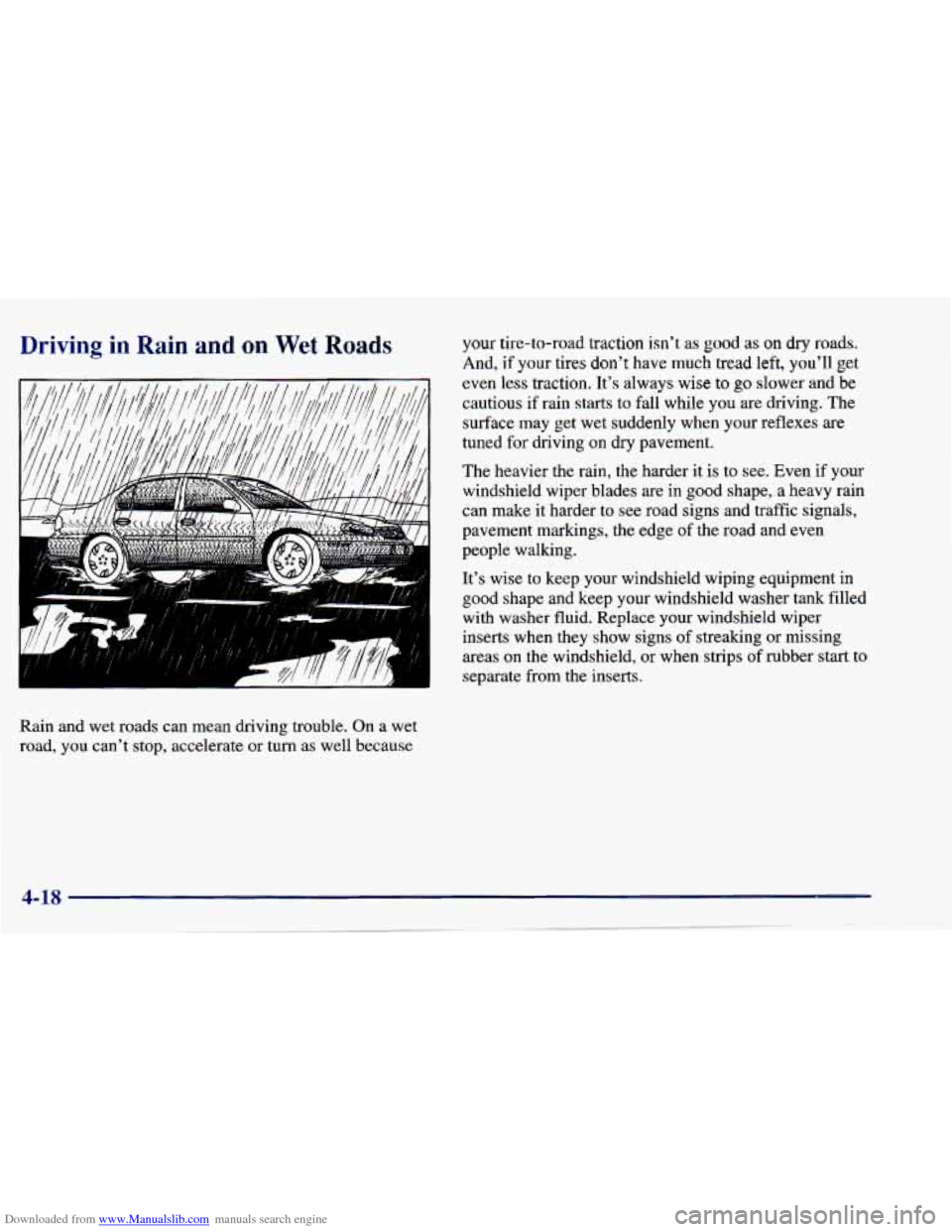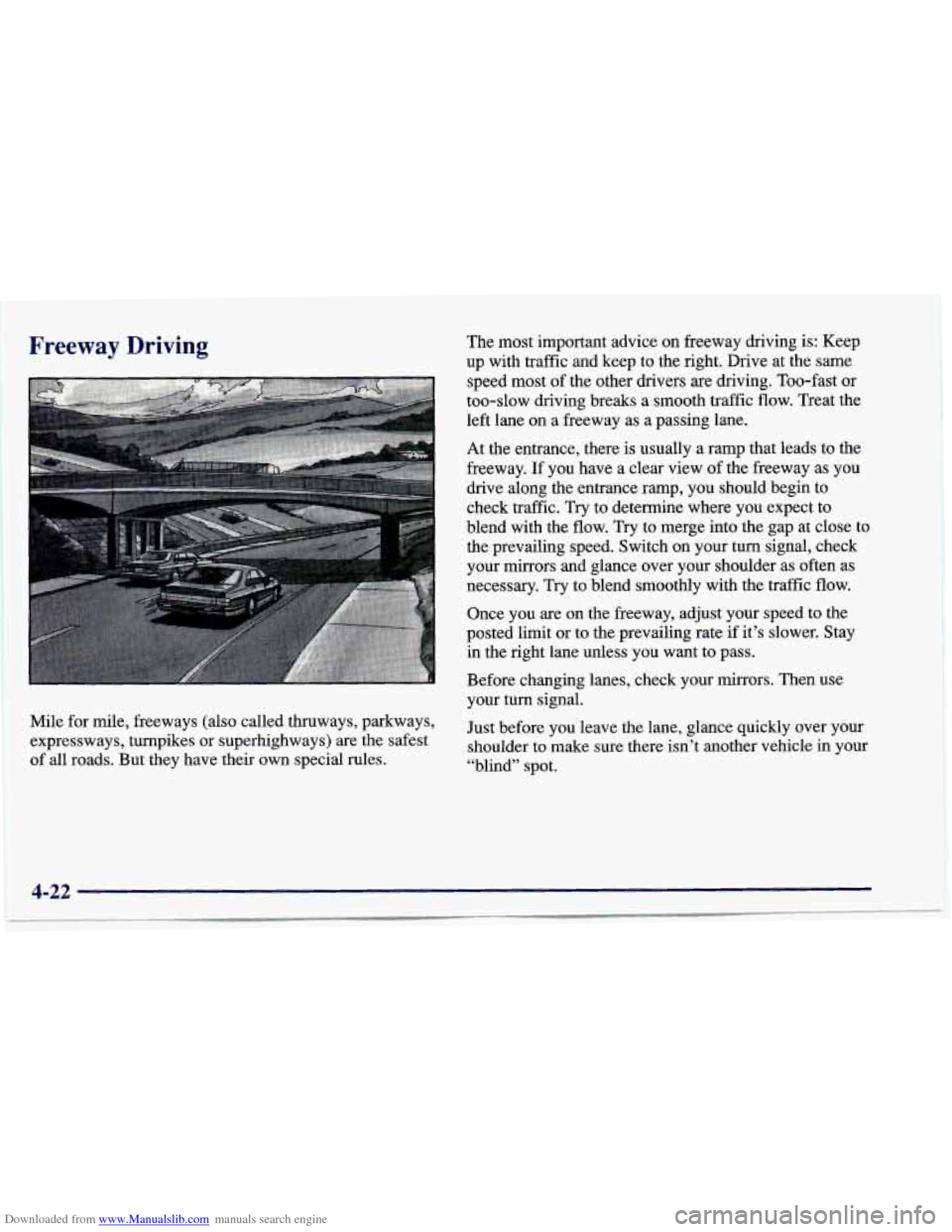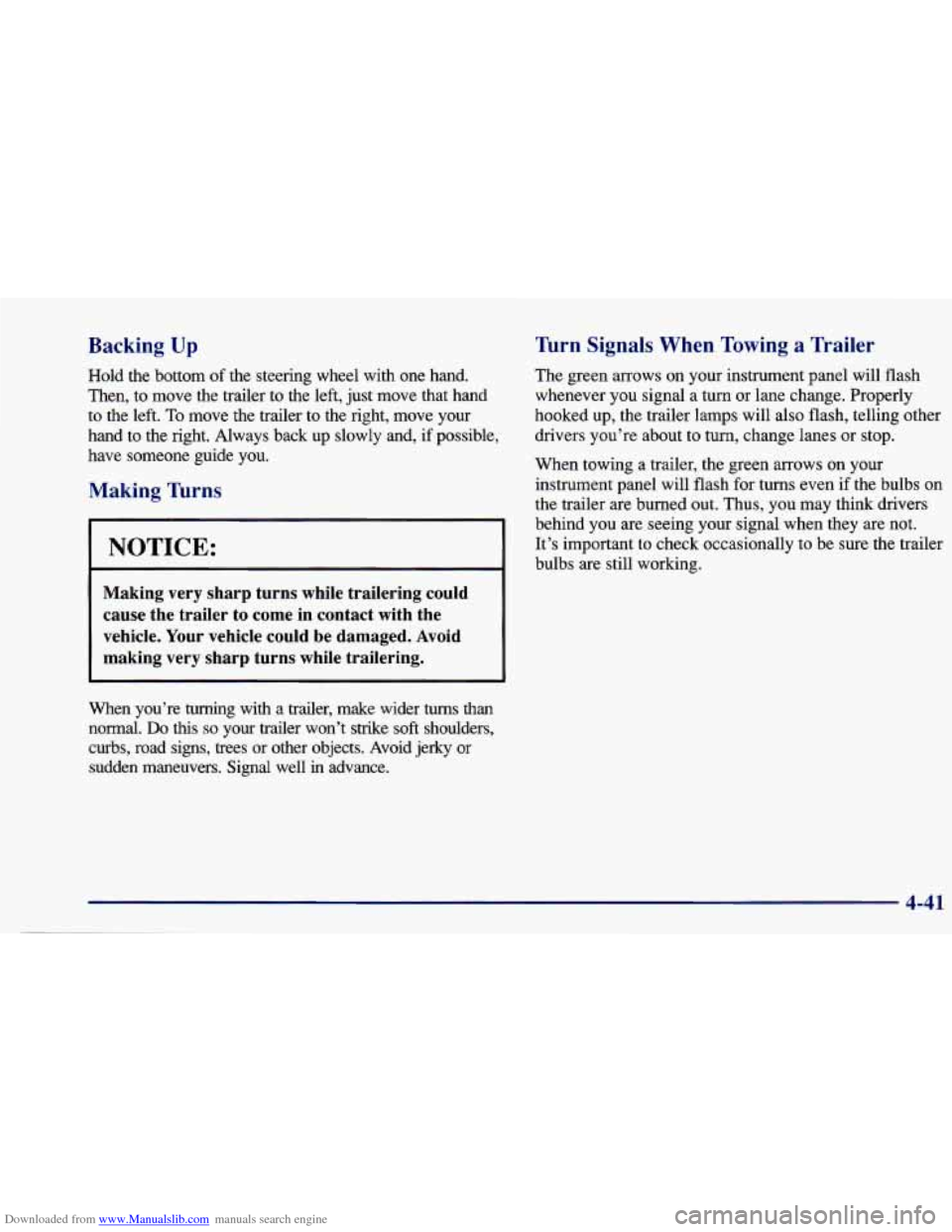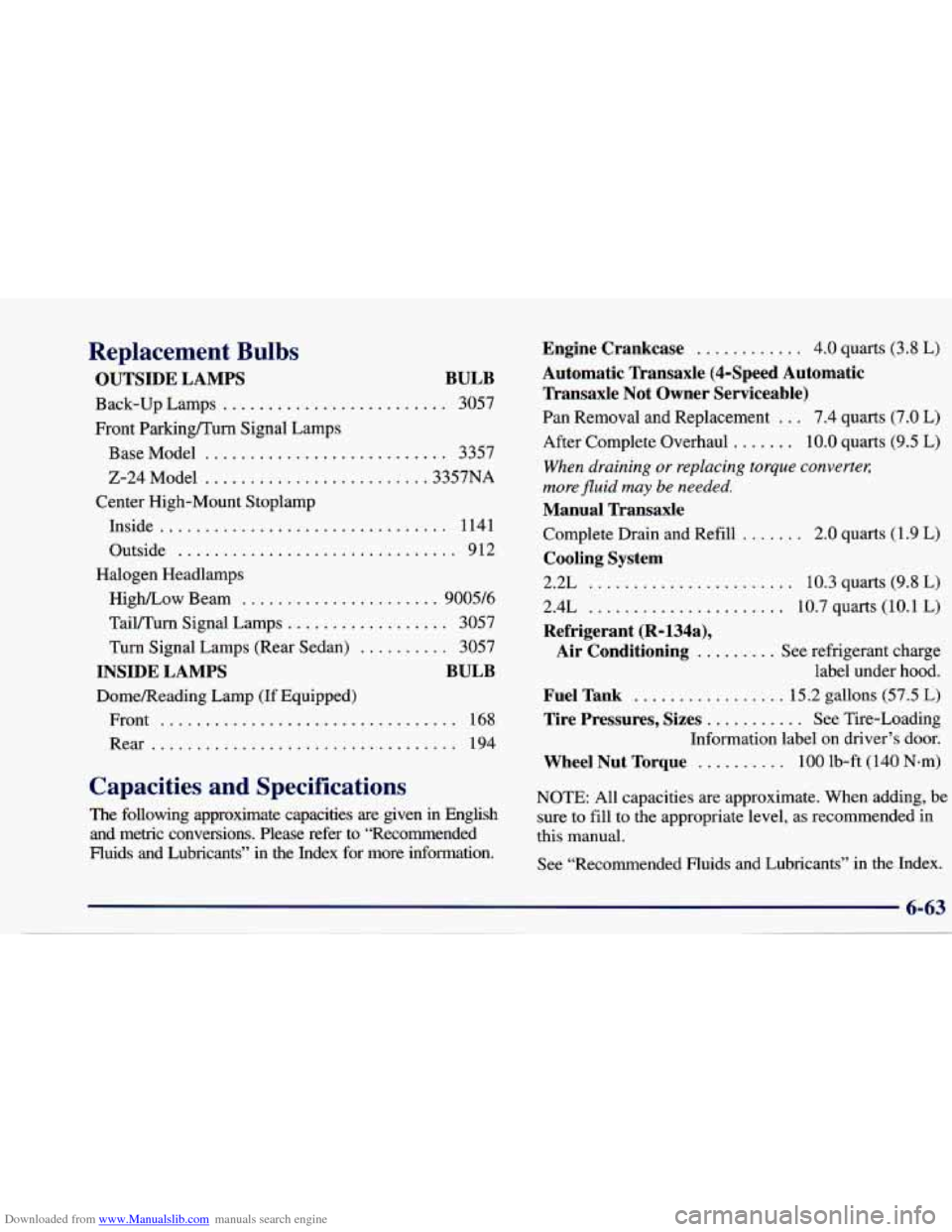Page 180 of 388

Downloaded from www.Manualslib.com manuals search engine Driving in Rain and on Wet Roads
Rain and wet roads can mean driving trouble. On a wet
road, you can't stop, accelerate
or turn as well because
your tire-to-road traction isn't as good as on dry roads.
And,
if your tires don't have much tread left, you'I1 get
even less traction. It's always wise to go slower and be
cautious if rain starts to fall while you are driving. The
surface may get wet suddenly when your reflexes
are
tuned for driving on dry pavement.
The heavier the rain, the harder it is to see. Even
if your
windshield wiper blades are in good shape, a heavy rain
can make it harder to see road signs and traffic signals,
pavement markings, the edge of the road and even
people walking.
It's wise to keep your windshield wiping equipment in
good shape and keep your windshield washer tank filled with washer fluid. Replace your windshield wiper
inserts when they show signs of streaking or missing
areas on the windshield, or when strips of rubber start to
separate from the inserts.
Page 183 of 388
Downloaded from www.Manualslib.com manuals search engine City Driving
One of the biggest problems with city streets is the
amount of traffic on them. You’ll want to watch out for
what the other drivers are doing and pay attention to
traffic signals. Here
are ways to increase your safety in city driving:
0 Know the best way to get to where you are
going. Get a city map and plan your trip into an
unknown
part of the city just as you would for a
cross-country trip.
0 Try to use the freeways that rim and crisscross most
large cities. You’ll save time and energy. (See the
next part, “Freeway Driving.”)
0 Treat a green light as a warning signal. A traffic light
is there because the comer is busy enough
to need it.
When a light turns green, and just before you start to
move, check both ways for vehicles that have not
cleared the intersection or may be running
the
red light.
Page 184 of 388

Downloaded from www.Manualslib.com manuals search engine Freeway Driving The most important advice on freeway driving is: Keep
up with traffic and keep
to the right. Drive at the same
speed most of the other drivers
are driving. Too-fast or
too-slow driving breaks a smooth traffic flow. Treat the
left lane on a freeway as
a passing lane.
At the entrance, there is usually a ramp that leads to the
freeway.
If you have a clear view of the freeway as you
drive along the entrance ramp, you should begin to check traffic. Try to determine where you expect to
blend with the flow. Try to merge into the gap at close to
the prevailing speed. Switch on your turn signal, check
your mirrors and glance over your shoulder as often as
necessary. Try to blend smoothly with the traffic flow.
Once you are on the freeway, adjust your speed to the
posted limit or to the prevailing rate if it’s slower. Stay
in the right lane unless you want to pass.
Before changing lanes, check your mirrors. Then
use
your turn signal.
for freeways thnxways7 parkways7 Just before you leave the lane, glance quickly over \
your
expressways7
Or are the safest shoulder to make sure there isn’t another vehicle in your
of all roads. But they have their own special rules. “blind” spot.
4-22
Page 203 of 388

Downloaded from www.Manualslib.com manuals search engine Backing Up
Hold the bottom of the steering wheel with one hand.
Then, to move the trailer to the left, just move that hand
to the left. To move the trailer to the right, move your
hand to the right. Always back up slowly and, if possible,
have someone guide you.
Making Turns
1 NOTICE:
Making very sharp turns while trailering could
cause the trailer to come in contact with the
vehicle. Your vehicle could be damaged. Avoid
making very sharp turns while trailering.
When you’re turning with a trailer, make wider turns than
normal.
Do this so your trailer won’t strike soft shoulders,
curbs, road signs, trees or other objects. Avoid jerky or
sudden maneuvers. Signal well
in advance.
Turn Signals When Towing a Trailer
The green arrows on your instrument panel will flash
whenever you signal a turn or lane change. Properly
hooked up, the trailer lamps will also flash, telling other
drivers you’re about to turn, change lanes or stop.
When towing a trailer, the green arrows on your
instrument panel will flash for turns even if the bulbs on
the trailer are burned out. Thus, you may think drivers
behind you are seeing your signal when they are not.
It’s important to check occasionally to be sure the trailer
bulbs are still working.
4-41
Page 208 of 388
Downloaded from www.Manualslib.com manuals search engine Hazard Warning Flashers
Your hazard warning flashers let you warn others. They
also let police know you have a problem. Your front and
rear turn signal lamps will flash
on and off.
- Move the switch to the right
to make your front and rear
turn signal lamps flash on
and
off.
Your hazard warning flashers work no matter what
position your key is in, and even if the key isn’t in.
To turn off the flashers, move the switch to the left.
When the hazard warning flashers
are on, your turn
signals won’t work.
5-2
Page 279 of 388
Downloaded from www.Manualslib.com manuals search engine 3. Disconnect the bulb base from the socket by lifting
the plastic locking tab.
4. Snap a new bulb into the socket.
5. Replace the bulb assembly by reversing Steps
1 through 3, making sure the lower leg of the
headlamp bracket is properly seated into the wedge
shaped retainer.
Rear Exterior Bulbs
Taillamps and Rear Turn Signal Lamps
For the type of bulb to use, see “Replacement Bulbs” in
the Index. The following instructions explain how to
change each bulb.
1. Pull the carpet away from the rear of the trunk.
2. Remove the taillamp bulb assembly by turning it
one-quarter of a turn counterclockwise.
6-37
Page 303 of 388

Downloaded from www.Manualslib.com manuals search engine Fuse
WIPER
ERLS
AIR BAG
EXT LAMP
PWR ACC
HVAC
RADIO
ALARM
CRUISE
L HDLP
CIG
Usage
Windshield Wipers,
Windshield Washers
Automatic Transaxle, Brake
Transaxle Shift Interlock, A/C
Compressor, Cruise Control,
Multiport Fuel Injection
Supplemental Inflatable
Restraint System
Exterior Lamps, Instrument
Panel Lights
Power Door Locks, Convertible
Top (Convertible Model)
Heater and A/C Control,
Anti-lock Brake System,
Engine Cooling Fan
Radio, Remote Keyless Entry
Alarm Module
- Interior Lamps,
Warning Chimes
Cruise Control
Left Headlamp Cigarette Lighter,
Horn, Interior
Lamps, Diagnostic Connector
Fuse
INST LPS
STOP HAZ
PWR WIN- DOW
PCM/IGN
INT LAMP
FOG LAMP
IGN
R HDLP
Usage
Instrument Panel Lights,
Warning Chimes
Exterior Lamps, Anti-Lock
Brake System, Cruise Control,
Turn Signals
Power Windows, Power Sunroof,
Convertible Top Controls
(Convertible Model)
(Circuit Breaker)
Powertrain Control Module
Alarm Module: Illuminated Entry,
Warning Chimes, Overhead
Lamps, Mapmeading Lamps,
Glove Box Lamp, Trunk Lamp,
Radio, Power Mirrors, Remote
Keyless Entry
Fog Lamps
(2-24 Only)
Engine Ignition
Right Headlamp
6-61
Page 305 of 388

Downloaded from www.Manualslib.com manuals search engine Replacement Bulbs
OUTSIDE LAMPS BULB
Back-up Lamps ......................... 3057
Front Parking/Turn Signal Lamps
BaseModel
........................... 3357
2-24Model
......................... 3357NA
Center High-Mount Stoplamp
Inside
................................ 1141
Outside
............................... 9 12
Halogen Headlamps High/Low Beam
...................... 9005/6
TaiVTurn Signal Lamps
.................. 3057
Turn Signal Lamps (Rear Sedan)
.......... 3057
INSIDE LAMPS BULB
Domemeading Lamp (If Equipped)
Front
................................. 168
Re x.................................. 194
Capacities and Specifications
The following approximate capacities are given in English
and metric conversions.
Please refer to “Recommended
Huids
and Lubricants” in the Index for more information.
Engine Crankcase ............ 4.0 quarts (3.8 L)
Automatic Transaxle (4-Speed Automatic
Transaxle Not Owner Serviceable)
Pan Removal and Replacement ... 7.4 quarts (7.0 L)
After Complete Overhaul ....... 10.0 quarts (9.5 L)
When draining or replacing torque converter;
more fluid may be needed.
Manual Transaxle
Complete Drain and Refill ....... 2.0 quarts (1.9 L)
Cooling System
2.2L ....................... 10.3 quarts (9.8 L)
2.4L
...................... 10.7 quarts (10.1 L)
Refrigerant (R=134a),
Air Conditioning
......... See refrigerant charge
label under hood.
Fuel Tank ................. 15.2 gallons (57.5 L)
Tire Pressures, Sizes ........... See Tire-Loading
Information label
on driver’s door.
Wheel Nut Torque .......... 100 lb-ft (140 Nem)
NOTE: All capacities are approximate. When adding, be
sure to fill to the appropriate level, as recommended in
this manual.
See “Recommended Fluids and Lubricants” in the Index.